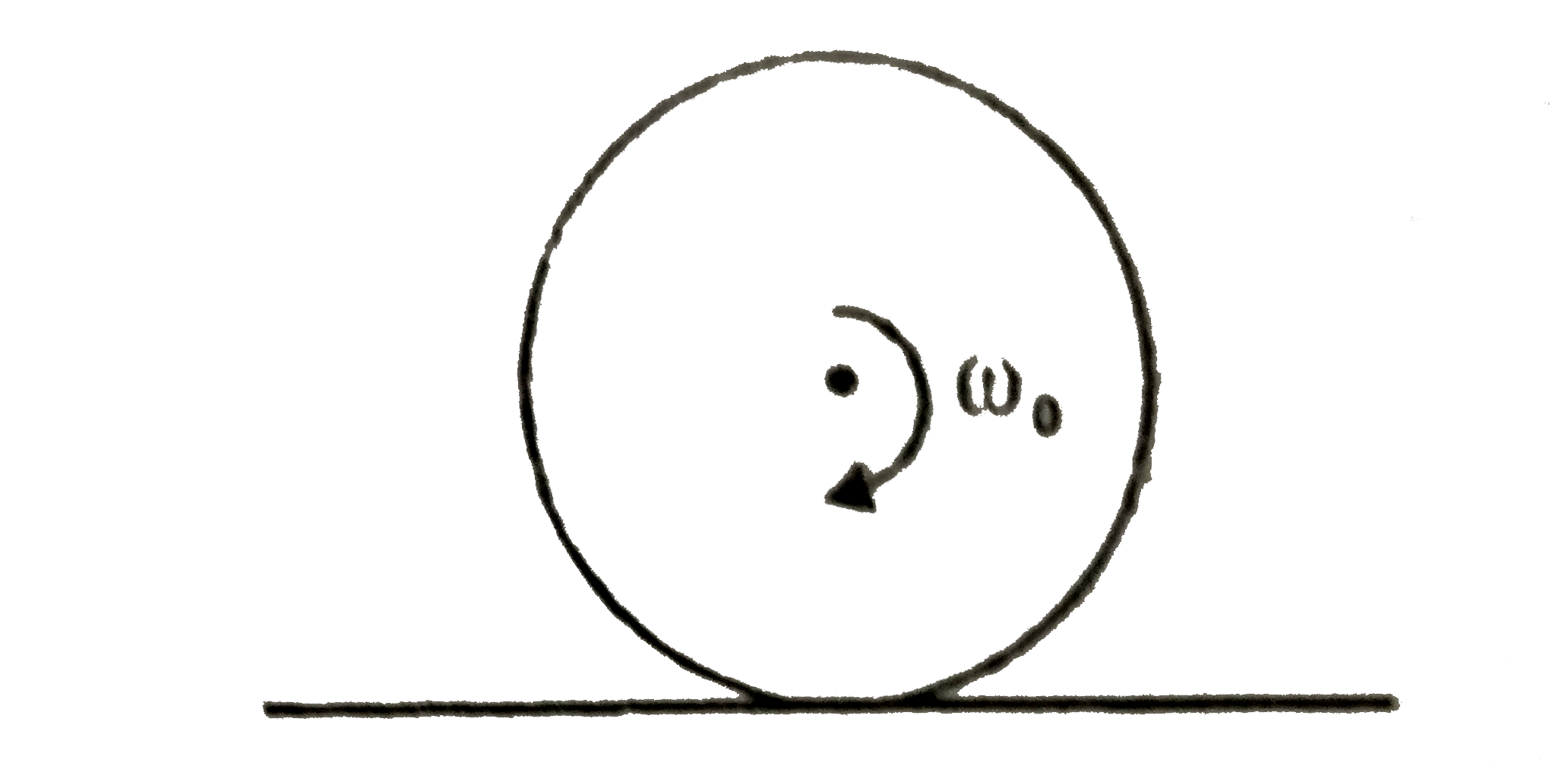A circular disc of mass M and radius R is rotating about its axis with angular speed If about another stationary disc having radius ω1.
R2 and same mass M is dropped co- axially on to the rotating disc. Gradually both discs attain constant angular speed ω2. The energy lost in the process is p% of the initial energy . Value of p is ........
The correct Answer is:0.0
To solve the problem, we need to analyze the situation step by step, focusing on the conservation of angular momentum and the calculation of kinetic energy before and after the smaller disc is dropped onto the larger rotating disc.
1. Identify the Moment of Inertia of the Discs:
- For the larger disc (Disc A) of mass M and radius R:
IA=12MR2
- For the smaller disc (Disc B) of mass M and radius R2:
IB=12M(R2)2=12MR24=18MR2
2. Calculate the Initial Angular Momentum:
- The initial angular momentum Li of the system (only the larger disc is rotating):
Li=IAω1=(12MR2)ω1
3. Calculate the Final Angular Momentum:
- After the smaller disc is dropped, both discs rotate together with a common angular speed ω2:
Ifinal=IA+IB=12MR2+18MR2=48MR2+18MR2=58MR2
- The final angular momentum Lf:
Lf=Ifinalω2=(58MR2)ω2
4. Apply Conservation of Angular Momentum:
- Setting initial angular momentum equal to final angular momentum:
12MR2ω1=58MR2ω2
- Cancel MR2 from both sides:
12ω1=58ω2
- Rearranging gives:
ω2=45ω1
5. Calculate Initial and Final Kinetic Energy:
- Initial kinetic energy Ki:
Ki=12IAω21=12(12MR2)ω21=14MR2ω21
- Final kinetic energy Kf:
Kf=12Ifinalω22=12(58MR2)(45ω1)2
Kf=12(58MR2)(1625ω21)=58MR2⋅825ω21=15MR2ω21
6. Calculate Energy Lost:
- Energy lost ΔK=Ki−Kf:
ΔK=14MR2ω21−15MR2ω21=(520−420)MR2ω21=120MR2ω21
7. Calculate Percentage Loss in Energy:
- Percentage loss p:
p=(ΔKKi)×100=⎛⎝120MR2ω2114MR2ω21⎞⎠×100=(1/201/4)×100=(120×41)×100=420×100=20
Final Answer
The value of p is 20.
- For the larger disc (Disc A) of mass M and radius R:
IA=12MR2
- For the smaller disc (Disc B) of mass M and radius R2:
IB=12M(R2)2=12MR24=18MR2
- The initial angular momentum Li of the system (only the larger disc is rotating):
Li=IAω1=(12MR2)ω1
- After the smaller disc is dropped, both discs rotate together with a common angular speed ω2:
Ifinal=IA+IB=12MR2+18MR2=48MR2+18MR2=58MR2
- The final angular momentum Lf:
Lf=Ifinalω2=(58MR2)ω2
- Setting initial angular momentum equal to final angular momentum:
12MR2ω1=58MR2ω2
- Cancel MR2 from both sides:
12ω1=58ω2
- Rearranging gives:
ω2=45ω1
- Initial kinetic energy Ki:
Ki=12IAω21=12(12MR2)ω21=14MR2ω21
- Final kinetic energy Kf:
Kf=12Ifinalω22=12(58MR2)(45ω1)2
Kf=12(58MR2)(1625ω21)=58MR2⋅825ω21=15MR2ω21
- Energy lost ΔK=Ki−Kf:
ΔK=14MR2ω21−15MR2ω21=(520−420)MR2ω21=120MR2ω21
- Percentage loss p:
p=(ΔKKi)×100=⎛⎝120MR2ω2114MR2ω21⎞⎠×100=(1/201/4)×100=(120×41)×100=420×100=20
The value of p is 20.
Topper's Solved these Questions
Similar Questions
A circular disc of mass 2 kg and radius 10 cm rolls without slipping with a speed 2 m/s. The total kinetic energy of disc is
View SolutionA thin circular ring of mass M and radius R is rotating about its axis with constant angular velocity ω. The objects each of mass m are attached gently to the ring. The wheel now rotates with an angular velocity.
View Solution
Knowledge Check
- Question 1 - Select One
A solid cylinder of mass M and radius R rotates about its axis with angular speed ω. Its rotational kinetic energy is
A12MR2ω2BMR2ω2C14MR2ω2D18MR2ω2
A wheel of moment of inertia I and radius R is rotating about its axis at an angular speed ω. It picks up a stationary particle of mass m at its edge. Find the new angular speed of the wheel.
View SolutionA wheel of moment of inertial I and radius R is rotating about its axis at an angular speed ω. It picks up a stationary particle of mass m at its edge. Find the new angular speed of the wheel.
View SolutionA circular disc of mass M and radius R rotating with speed of ω and another disc of same mass M and radius R/2 placed co axially on first disc, after sometime disc-2 also attain constant speed w2 . Find loss of percentage in energy
View SolutionA circular disc of moment of inertia It is rotating in a horizontal plane about its symmetry axis with a constant angular velocity ωi. Another disc of moment of inertia Ib is dropped co-axially onto the rotating disc. Initially, the second disc has zero angular speed. Eventually, both the discs rotate with a constant angular speed ωf. Calculate the energy lost by the initially rotating disc due to friction.
View SolutionA disc of mass m and radius R rotating with angular speed ω0 is placed on a rough surface (co-officient of friction =μ). Then
 View Solution
View SolutionA uniform circular disc of mass 200 g and radius 4.0 cm is rotated about one of its diameter at an angular speed of 10 rad/s. Find the kinetic energy of the disc and its angular momentum about the axis of rotation.
View SolutionA disc of the moment of inertia 'l1' is rotating in horizontal plane about an axis passing through a centre and perpendicular to its plane with constant angular speed 'ω1' . Another disc of moment of inertia 'I2'. having zero angular speed is placed discs are rotating disc. Now, both the discs are rotating with constant angular speed 'ω2'. The energy lost by the initial rotating disc is
View Solution

